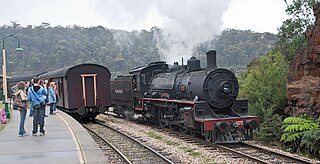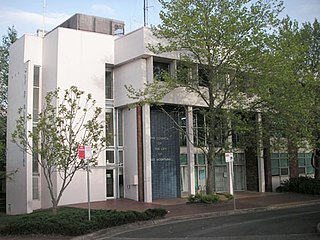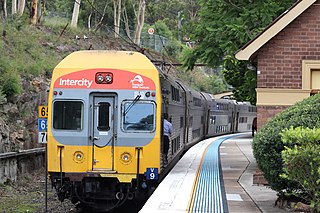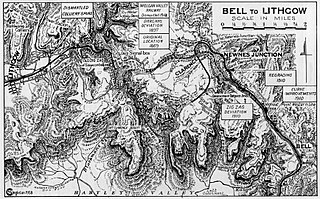| Glenbrook Deviation (1892) | |
|---|---|
| Overview | |
| Status | Closed; superseded by the Glenbrook Deviation (1913) |
| Owner | RailCorp |
| Locale | Blue Mountains, New South Wales, Australia |
| Termini |
|
| Service | |
| Type | Heavy rail |
| System | Main Western line |
| History | |
| Opened | December 1892 |
| Closed | 25 September 1913 |
| Technical | |
| Track length | approx. 5 miles (8 km) |
| Number of tracks | Single (since removed) |
| Track gauge | 4 ft 8+1⁄2 in (1,435 mm) standard gauge |
New South Wales Heritage Database (Local Government Register) | |
| Official name |
|
| Type | Local government heritage (built) |
| Designated | 27 December 1991 |
| Reference no. | G018 |
| Type | Railway line |
| Builders | Department of Railways |
The Glenbrook deviation was a section of track on the Main Western line from the first Knapsack Viaduct to old Glenbrook station in the Blue Mountains of New South Wales, Australia. The approximately five-mile-long (eight-kilometre) deviation was constructed from 1891 to 1892 and replaced the Lapstone Zig Zag. The deviation was closed in 1913 when it was replaced by the second Glenbrook deviation and the second Glenbrook Tunnel, [1] that continues to carry the Main Western line today. [2] [3]
In 1890 it was proposed to bypass the troublesome Lapstone Zig Zag by using a tunnel. This proposal was approved and in March 1891 tenders were called for its construction. The line left Bottom Points and continued into a gully before entering the 2,165-foot-long (660 m) tunnel, on a continuous 1-in-33 gradient. [1] After emerging just below the original alignment, the line curved to the left and ascended slightly before rejoining the original line at Glenbrook. The site of the original Glenbrook Station now lies to the right of the Great Western Highway, near the skate park.
However, the deviation soon proved to be somewhat of a disaster. Even if it did eliminate the Zig Zag which restricted train length, the problem was the design of the tunnel. The first problem was the climb, the tunnel being on a steep, continuous 1-in-33 gradient. The second and main problem was ventilation. The tunnel was single-track, which made the dimensions tight, and towards one end was a curve, which made the ventilation even worse. Passengers found themselves fighting off smoke and fumes from the locomotive. [1] Trains would begin slipping halfway through the tunnel, forcing engine crews to retreat for air. [4] In one incident of 1908, a retreating train met with another down goods train in a collision at the tunnel mouth.
In 1910, work started on a new deviation when the Main Western Line over the Blue Mountains was being duplicated at the time. [5] The second Glenbrook deviation replaced the 1-in-33 deviation with a more gentle 1-in-60 ruling grade across Glenbrook Gorge. [6]
During World War II, the tunnel was used to store bombs and ammunition. After the war however, the tunnel found a useful purpose as a mushroom farm, which continued up until 2016. [7] The upper area has been cleared, though the years of detritus has been left to rot in the tunnel making it unsafe for healthy exploration. The lower area has benefited from the years of mushroom farming by being fed the run-off and is difficult to access. [8]

Great Western Highway is a 202-kilometre-long (126 mi) state highway in New South Wales, Australia. From east to west, the highway links Sydney with Bathurst, on the state's Central Tablelands.

Glenbrook is a township of the Lower Blue Mountains of New South Wales, Australia. It is located 63 kilometres west of the Sydney central business district, in the local government area of the City of Blue Mountains. As of the 2021 Australian census Glenbrook had a population of 5,078 people.

A railway zig zag or switchback is a railway operation in which a train is required to switch its direction of travel in order to continue its journey. While this may be required purely from an operations standpoint, it is also ideal for climbing steep gradients with minimal need for tunnels and heavy earthworks. For a short distance, the direction of travel is reversed, before the original direction is resumed. Some switchbacks do not come in pairs, and the train may then need to travel backwards for a considerable distance.

The Zig Zag Railway is an Australian heritage railway, situated near Lithgow, New South Wales. It was opened by the not-for-profit Zig Zag Railway Co-op as an unpaid volunteer-staffed heritage railway in October 1975, using the alignment of the Lithgow Zig Zag line that formed part of the Main Western line between 1869 and 1910. The line climbs the western flank of the Blue Mountains, using railway zig zags to gain height.

The City of Blue Mountains is a local government area of New South Wales, Australia, governed by the Blue Mountains City Council. The city is located in the Blue Mountains, on the Great Dividing Range at the far western fringe of the Greater Sydney area.

Lapstone is a township on the eastern escarpment of the Blue Mountains in New South Wales, Australia. Elevation 160 m (525 ft). Lapstone is located 62 kilometres west of the Sydney CBD in the local government area of the City of Blue Mountains and is part of the federal electorate of Macquarie. Lapstone consists mostly of stand-alone housing and has a few public facilities. At the 2016 census, Lapstone had a population of 961 people. Lapstone was originally bought and developed by Mr Arthur J Hand, an Alderman of the Blue Mountains City Council.

The Lapstone Zig Zag was a zig zag railway built between Emu Plains and Blaxland stations on the Main Western Line of New South Wales in Australia. Constructed between 1863 and 1865 to overcome an otherwise insurmountable climb up the eastern side of the Blue Mountains, the zig zag and associated Knapsack Viaduct, a sandstone arch viaduct, were designed by John Whitton, Engineer-in-Charge of New South Wales Government Railways, and were built by William Watkins. The zig zag was listed on the Blue Mountains local government heritage register on 27 December 1991; while the adjacent Knapsack Viaduct was listed on the New South Wales Heritage Database on 2 April 1999. The Lapstone Zig Zag was the world-first Zig Zag constructed on any main-line railway.

The Blue Mountains Line (BMT) is an inter urban commuter rail service operated by NSW TrainLink serving the Blue Mountains region of New South Wales, Australia. The line travels west from Sydney to the major town of Katoomba and on to Mount Victoria, Lithgow and Bathurst. Mount Victoria is the terminus for most electric services, but some services terminate at Lithgow instead. Two express services per day in each direction, known as the Bathurst Bullet, extend to the regional city of Bathurst, which is supplemented by road coaches connecting Bathurst to Lithgow. Due to electrification limits at Lithgow, the Bathurst Bullet is run using the Endeavour railcars, which operate on diesel. The Blue Mountains Line operates over a mostly duplicated section of the Main Western line. As such, the tracks are also traversed by the Central West XPT, Outback Xplorer and Indian Pacific passenger services and by freight trains.

Zig Zag railway station is located on the New South Wales Main Western Line. It was originally built in April 1878 and closed in 1910 due to the opening of the Ten Tunnels Deviation which bypassed the original site of the station. The station was not rebuilt until 1959 when a new station was built alongside the 1910 alignment in a similar location to the 1878 station.

John Whitton, an Anglo–Australian railway engineer, was the Engineer-in-Charge for the New South Wales Government Railways, serving between 1856 and 1890, considered the Father of New South Wales Railways. Under his supervision, it is estimated that 2,171 miles (3,494 km) of railway around New South Wales and Victoria were completed. Whitton was responsible for the construction of parts of the Main Western railway line, in particular the section over the Blue Mountains and the Lithgow Zig Zag, and much of the Main Southern railway line.
The Main Western Railway is a major railway in New South Wales, Australia. It runs through the Blue Mountains, Central West, North West Slopes and the Far West regions. It is 825 kilometres (513 mi) with 484 kilometres (301 mi) operational & 341 kilometres (212 mi) under construction & repairs.
Clarence is a location in New South Wales, Australia. It was originally a railway outpost on the original railway line across the Blue Mountains, but by 1908 when Clarence was used as headquarters for the Ten Tunnels Deviation works, the town population had flourished to over 5,000 residents, the majority being the navvies employed on the deviation works. When the deviation was opened in 1910, the town population quickly fell, despite a new platform built on the new deviation.

The Lithgow Zig Zag is a heritage-listed former zig zag railway line built near Lithgow on the Great Western Line of New South Wales in Australia. The zig zag line operated between 1869 and 1910, to overcome an otherwise insurmountable climb and descent on the western side of the Blue Mountains. It was designed by John Whitton and built from 1863 to 1869 by Patrick Higgins as contractor. It is also known as the Great Zig Zag Railway and Reserves and Zig Zag Railway. The property is owned by Department of Planning and Infrastructure. It was added to the New South Wales State Heritage Register on 2 April 1999.
The Clarence Tunnel is a railway tunnel that was originally part of the Main Western railway line across the Blue Mountains, New South Wales, Australia. It is 493 metres (539 yd) long.

The Ten Tunnels Deviation is a heritage-listed 9.2-kilometre (5.7 mi) section of the Main Western Line between Newnes Junction and Zig Zag stations in Lithgow, New South Wales, Australia. It was designed and built by the New South Wales Government Railways and built from 1 June 1908 and 16 October 1910. It is also known as Great Zig Zag Railway deviation tunnels and Bell to Zig Zag Ten Tunnel Railway Deviation. It was added to the New South Wales State Heritage Register on 2 April 1999.

The Glenbrook Tunnel is a heritage-listed single-track former railway tunnel and mustard gas storage facility and previously a mushroom farm located on the former Main Western Line at the Great Western Highway, Glenbrook, in the City of Blue Mountains local government area of New South Wales, Australia. The Department of Railways designed the tunnel and built it from 1891 to 1892. It is also known as Lapstone Hill tunnel and Former Glenbrook Railway and World War II Mustard Gas Storage Tunnel. The property is owned by Blue Mountains City Council and Land and Property Management Authority, an agency of the Government of New South Wales. It was added to the New South Wales State Heritage Register on 5 August 2011. The railway tunnel was originally part of the Glenbrook 1892 single-track deviation, which bypassed the Lapstone Zig Zag across the Blue Mountains. It is 634 metres; 693 yards long and is constructed in an 'S' shape with a gradient of 1:33.

The Rydal rail underbridges are a series of heritage-listed railway underbridges and viaducts that carry the Main Western line over Solitary Creek at Rydal, in the City of Lithgow local government area of New South Wales, Australia. The property is owned by Transport Asset Holding Entity, an agency of the Government of New South Wales. It was added to the New South Wales State Heritage Register on 2 April 1999.
The Glenbrook Tunnel is a double-track railway tunnel located on the Main Western Line, near Glenbrook, in the City of Blue Mountains local government area of New South Wales, Australia. The property is owned by the Transport Asset Holding Entity. The railway tunnel is part of the Glenbrook 1913 double-track deviation, which replaced the Glenbrook 1892 single-track deviation across the Blue Mountains. The tunnel is 283 metres (928 ft) long and was officially opened on 11 May 1913.
The Glenbrook deviation is a section of track on the Main Western line from Emu Plains to Blaxland stations in the Blue Mountains of New South Wales, Australia. The approximately seven-mile-long (eleven-kilometre) double-track deviation was constructed from 1911 to 1913 and replaced the single-track first Glenbrook deviation and the first Glenbrook Tunnel.
{{citation}}: CS1 maint: multiple names: authors list (link) CS1 maint: numeric names: authors list (link)